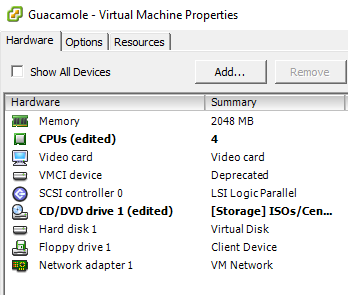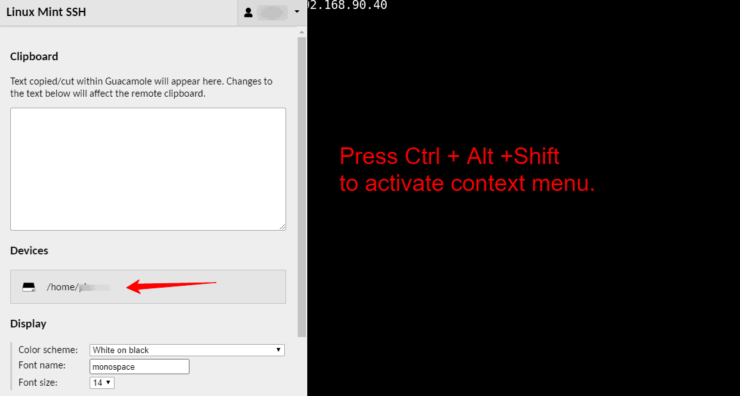
- Guacamole centos 7 install guide how to#
- Guacamole centos 7 install guide upgrade#
- Guacamole centos 7 install guide full#
- Guacamole centos 7 install guide software#
- Guacamole centos 7 install guide iso#
Choose only the services that are crucial for your network infrastructure. The range of services you can choose from is diversified, from Backup, DNS or e-mail services to File and Storage services, FTP, HA or Monitoring tools.

Assuming that you want to install a Graphical User Interface for your server, choose Server with GUI item from the left plane and check the proper Add-ons from the right plane depending on what kind of services the server will provide to your network clients.
Guacamole centos 7 install guide software#
Gnome Desktop Software Selection KDE Desktop Software SelectionĨ.
Guacamole centos 7 install guide full#
CentOS 7.5 Software Selectionįor a full Gnome or KDE Desktop environment use the below screenshots as a guide. In order to subsequently customize your system, select Minimal Install with Compatibility Libraries add-ons and hit on Done button to continue. On the next step you can configure your base machine environment by hitting on Software Selection button.įrom the left list you can opt to install a desktop environment ( Gnome, KDE Plasma or Creative Workstation) or choose a server custom installation type ( Web server, Compute Node, Virtualization host, Infrastructure server, Server with a graphical interface or File and Print Server) or perform a minimal installation. When you finish click on Done button to continue with the installation process.

Set the desired security profile by hitting on Select profile button and Apply security policy button to ON. In this step you can setup your system Security Policy by choosing a security profile from the list. Next, add or configure the language support for your system and hit Done to move to the new step. Choose or add a keyboard layout and hit on Done to continue. On the next step setup the keyboard layout by hitting on Keyboard menu. CentOS 7.5 Installation Summary Select Date and TimeĤ. Make sure the date and time are correctly configured and hit on Done button to go back to the main installer screen. On the next screen hit on Date and Time and choose your geographical location from the map. Select CentOS 7.5 Installation Languageģ. Choose the language you want to perform the installation process and press hit on Continue button.
Guacamole centos 7 install guide iso#
After the install ISO image has been loaded into your machine RAM, the welcome screen will appear.


From the menu select Install CentOS 7 and hit Enter to continue. Once the ISO image boots-up, the first screen will appear on your machine output. Place the USB/DVD in the appropriate motherboard drive, reboot your machine and instruct the BIOS/UEFI to boot-up from the DVD/USB by pressing a special function key (usually F12, F10 depending on the vendor specifications). After you’ve downloaded the image from the above link, burn it to a DVD or create a bootable UEFI compatible USB drive using Rufus utility. In order to properly perform the installation of CentOS 7.5 on a UEFI based machine, first enter your motherboard UEFI settings by pressing a special key ( F2, F11, F12 depending on motherboard specifications) and assure that QuickBoot/ FastBoot and Secure Boot options are disabled.
Guacamole centos 7 install guide how to#
In this article, we will show how to install a fresh CentOS 7.5 using the DVD ISO image with a graphical user interface (GUI) on a UEFI based machine. We strongly recommend you to perform a fresh installation rather than upgrading from other major CentOS versions.
Guacamole centos 7 install guide upgrade#
Download CentOS 7.5 DVD ISO’sĬentOS Linux is developed to automatically upgrade to a new major version ( CentOS 7.5) by running the following command that will upgrade your system seamlessly from any earlier CentOS 7.x release to 7.5. It’s highly recommended to go through release notes as well as the upstream technical notes about the changes before an installation or up-gradation. The latest version of CentOS 7.5, a Linux platform based on sources of Red Hat Enterprise Linux 7.5, has been released in May this year with many bug fixes, new packages & upgrades, such as Microsoft Azure, Samba, Squid, libreoffice, SELinux, systemd and others and support for the 7th generation of Intel Core i3, i5, i7 processors.


 0 kommentar(er)
0 kommentar(er)
